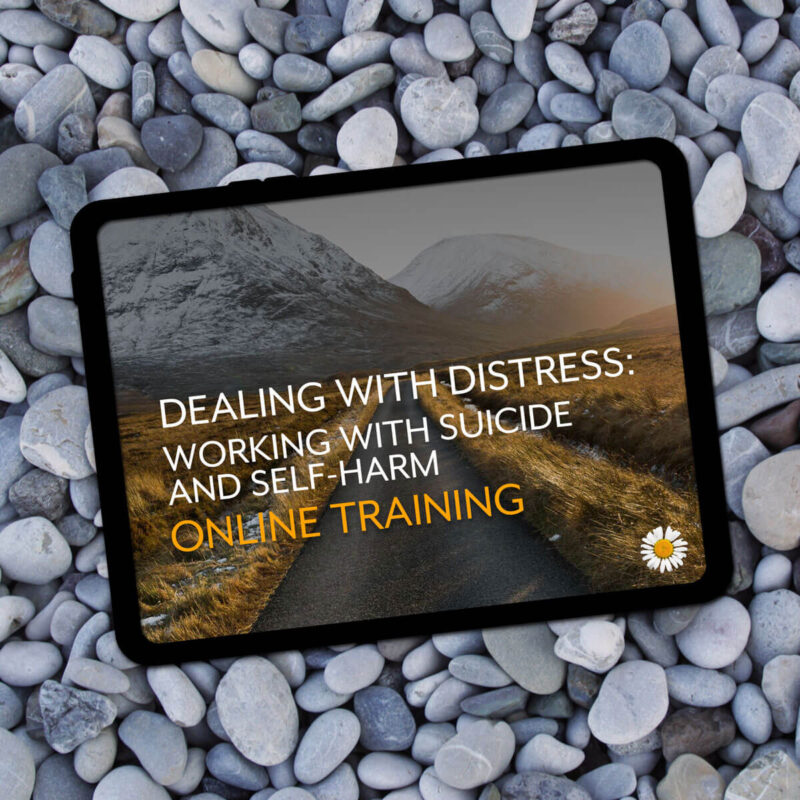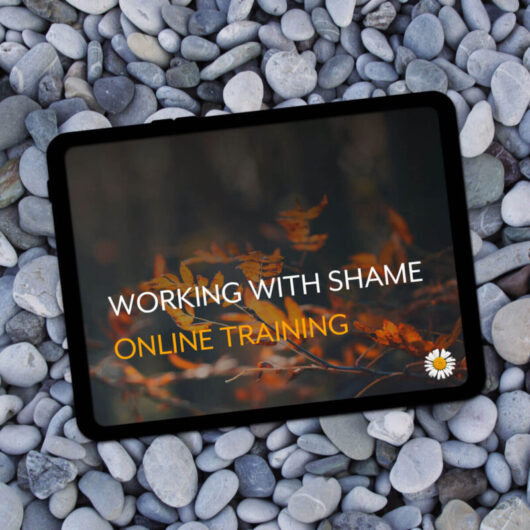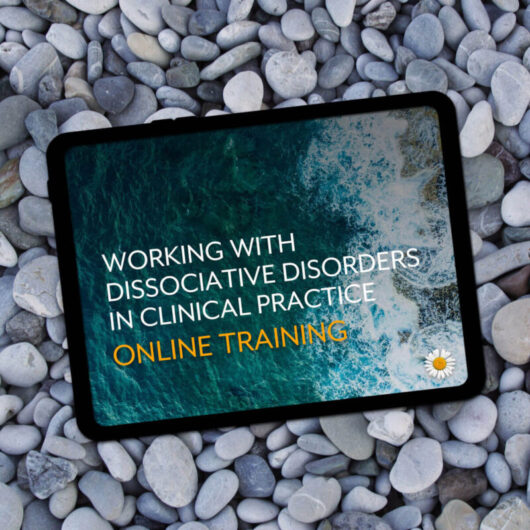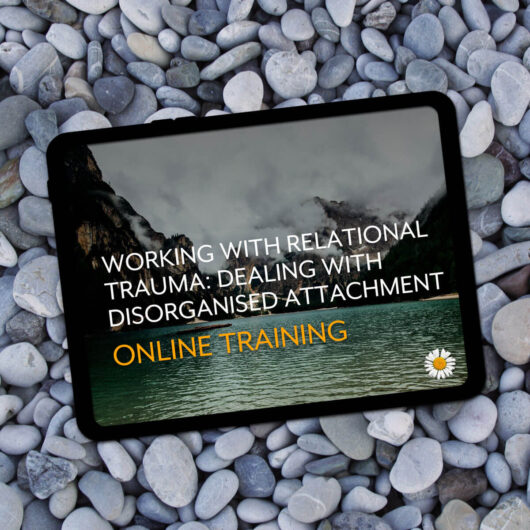Dealing with Distress: Working with Suicide and Self-Harm Online Training
Our default response to self-harm and suicidality is to think in terms of ‘risk’. But what if that approach in itself actually increases the risk? What if, instead, we thought in terms of reducing distress, and what if by doing that it in fact also reduced the risk?
This course looks at how to develop a collaborative – and kinder – approach to working with people in intense pain, and explains the fundamental but enlightening neuroscience behind both self-harm and suicide.
“I have worked for Mind and been a Samaritan and I only wish I had had this training first.”
“I found this training to be one of the best I have ever taken. Carolyn has created an incredibly helpful, insightful and truly useful course here. Her message of a ‘hope-filled life’ and our role as ‘coach’ in helping our clients achieve this is so empowering both for client and therapist. Her generosity with regards to providing resources has not gone unnoticed either. Thank you so much Carolyn … you are a shining light in what is often a very dark place.”
“A very different and very insightful course, where the author takes the time to go in-depth into aspects often only brushed upon, like the neurobiological perspective on suicide and self-harm. Several concepts, like the ‘blue zone’, or the ‘recovery triangle’ are incredibly helpful to consider. But maybe most importantly, the whole course revolves around the reduction of distress, rather than the ‘prevention’ of suicide and self-harm, which is very close to my own philosophy. It is respectful, considerate and vigorous in its overall tone. I warmly recommend it.”
“This course has given me a different insight into distress, and how and why that might lead to suicide or self-harm. It’s a well-thought-through and structured course, in good-sized lessons, and I really appreciated the additional links and supporting material. It has given me a lot to reflect on, and consider in my practice for all my clients in distress.”
“Carolyn’s insight and the solid research that she does, mean that the training that she offers practitioners is both evidence-based, academic and uniquely, it is based on the experience of someone who has sat in the client’s seat and has experienced a journey of healing. Thank you Carolyn for providing such important training.”
“This training was informative and (strangely) uplifting. Carolyn clearly explained what so many other training courses I have taken haven’t, and this is how best to support someone in crisis. I will be able to use her models and explanations and take them into many other aspects of the counselling work and not just suicide and self-harm. Thank you for you all you do this this subject, you’re brilliant.”
“Excellent – a whole new way of thinking when working with clients. Useful resources to share,
“I found this course so inspirational. It helped to give me clarification and a sense of therapeutic direction.
“This has been a well-paced and informative course. Carolyn has a wonderful way of being able to relate to her thinking and understanding of her world and how to enable others to shift towards a life deserved. I will be making sure the GPs and nurses I work with attend this training. Thank you so much!”
“Absolutely excellent! The best training on working with suicidal distress I’ve done.”
“Amazing – it has really challenged me to think about suicide and self-harm in a new way.”
“I was really impressed with the whole course & the overwhelmingly positive messages it left me with. I thought the whole course was very well-researched, written & presented. I wasn’t looking forward to studying this course particularly, but feel better equipped, more confident & with more psychoeducation about the pathology, my role when working with distressed clients, & galvanised to work in a more ‘challenging’ way with some of my clients. Thank you, Carolyn.”
- Available instantly upon purchase
- No set schedule – work at your own pace
- 6 hours of CPD with certificate upon completion
- Downloadable resources and additional reading for a comprehensive learning experience including:
- Course Notebook (with space for notes, reflection questions, session summaries, references and links)
- PowerPoint handouts (two versions, one with space for notes, one for easy printing)
- Set of psychoeducational posters (full-colour and low-ink versions)
- MP3 audio files
- Videos available to stream or also downloadable for offline viewing
- Lifetime access
- Start/stop and return as often as you like
- Easy to use: only needs a web browser and PDF reader
- Individual licence only: for multiple users and information about discounts for organisations, please click here.
‘Suicide is a calamity of the inner world, where feelings, memories, and beliefs may brew up hurricane winds of anguish powerful enough to blow someone away.’ – John Maltsberger.
After suicide, there are no second chances. We can’t go back and try a different, or better way, of supporting someone to see if that works instead. We may have just the one chance to get it right, and none of us wants to get it wrong.
‘No one is killing themselves on my watch!’ we may vow. And yet a million people worldwide kill themselves each year. If a million people every year died as a result of terrorism, imagine the outcry, the public attention, the funding, and the need for a solution.
Research reveals a fair bit about the risk factors for suicide. But does that information enable us to predict with any accuracy whether our client, or our friend, or our family member will attempt to kill themselves?
This course looks at a variety of issues around self-harm and suicidality, specifically behaviours resulting from states of extreme distress linked to trauma. The aim of the course is to build your confidence in working with or supporting people who are severely distressed, and to equip you to work as effectively as possible to promote recovery and healing from this distress, so that self-harm and suicide are no longer seen as ‘the only way out’. I look at questions such as:
- How can you tell if someone is imminently suicidal – is it even possible? – and what should you then do about it?
- How can we help someone who is suicidal without getting stuck in a battle between life and death?
- Is someone suicidal ‘mentally ill’, and do they have ‘mental capacity’?
- Why do some people self-harm? Is it just ‘attention-seeking’? In what way might it make sense at a neurobiological level?
- Does self-harm increase or decrease the risk of completed suicide?
- Do policies to prevent suicide actually work, or might they actually be increasing the risk?
- How can we help people who are in severe distress without them becoming too ‘dependent’?
- Does hospitalisation work, or does it make things worse?
- What can we actually DO to help people feel better?
This course, aimed principally at counsellors and psychotherapists, but also suitable for a wide range of professionals and indeed anyone supporting survivors of trauma, looks at how to work safely and effectively with self-harm and suicide: to cope with crisis and deal with distress. It is based on the latest theory and neuroscience research, alongside my own narrative of numerous suicide attempts, what helped and what didn’t.
SESSION SUMMARIES
Session 1
- Exploring the phenomenological experience of a person experiencing suicidal crisis.
- Understanding theories of causation of suicidality and how these can impact upon a person-centered approach to working with people who are suicidal.
- Gaining perspective on trends in rates, methods and demographics of death by suicide in the UK.
- Exploring the characteristics of demographic groups at high risk for suicide.
- Exploring the limitations of applying ‘suicide risk factors’ based on wide demographics to individuals.
Session 2
- Exploring the factors from pre-birth through to adulthood that increase the risk of suicide in an individual’s life, including genetic, in utero neurochemical exposure, birth trauma, family history of suicide, adverse childhood experiences (ACES), attachment, socioeconomic factors, alcohol and drug use, mental illness, and current distress triggers.
- Exploring the 3 A’s of suicidality – alone, alcohol and agitation.
- Exploring the work of Edwin Shneidman and his cubic model of suicide – the 3 P’s of pain, press and perturbation.
- Exploring the work of David Jobes to expand the cubic model to 6 measures and the ‘Suicide Status Form’ as part of the CAMS framework (Collaborative Assessment and Management of Suicidality).
- Introducing the concept of completed suicides being driven by a neurobiological state known as ‘the suicidal mode’.
- Exploring the limitations of common assessments such as CORE-OM for predicting risk of suicide.
- Introducing the limitations of the Government’s assessment of suicide risk based on high-risk groups and the ‘prediction-prevention model’.
Session 3
- Exploring the unintended ‘risk of risk’ of the prediction-prevention model and its tendency to promote anxiety-driven behaviours from professionals.
- Exploring how the prediction-prevention model may result in responses of too little (avoidance) or detention (too much).
- Exploring how psychiatric detention can increase distress and powerlessness and thus increase the risk of suicide.
- Exploring the possibility of a shame and blame response to people with active suicidal feelings.
- Exploring the assessment-diagnosis-treatment model and its focus on pathology and risk rather than the relief of human suffering and distress.
- Exploring alternative ways of conceptualising suicidal feelings other than as an expression of mental illness.
- Exploring the NICE guidelines for self-harm and their early emphasis on mental capacity rather than mental distress.
Session 4
- Exploring the neurobiology of the ‘suicidal mode’.
- Understanding three key characteristics of the ‘suicidal mode’.
- Exploring the overlap between the ‘suicidal mode’ and traumatic brain states.
- Understanding the dual neurobiological states of ‘danger mode’ versus ‘daily life mode’ and how suicidality represents a vicious cycle of activation of ‘danger mode’.
- Exploring the relevance of the trauma traffic light (polyvagal theory) to suicidality.
- Exploring self-harm in terms of the trauma traffic light and a neurobiological need to escape the agitation of the amber zone by self-inducing the red zone.
Session 5
- Exploring the neurobiological value and intent of self-harm as a possible attempt to avert suicide rather than as a prelude to it.
- Examining the neurobiological vicious cycle of self-harm and how instead via key autonomic and relational interventions it can segue into a virtuous cycle of soothing.
- Exploring how to use the trauma traffic light to both manage suicidal distress and also to assess suicidal risk.
- Introducing the concept of the suicidal mode as ‘blue zone’ and its neurobiological characteristics, including its correlates to trauma.
- Exploring how the current prediction-prevention model conflates amber, red and blue zones and how instead to tease them apart for more useful risk assessment and response.
- Exploring the intersubjective neurobiological nature of the autonomic nervous system and how to use the green zone to mitigate suicidal distress.
Session 6
- Exploring the idea of developing an ‘emergency box’ when faced with suicidal crisis and how this relates to specific suicidal ‘blue zone’ brain states.
- Mapping three front brain areas (dorsolateral prefrontal cortex, medial prefrontal cortex, right orbitofrontal cortex) to discrete and targeted suicide-prevention strategies, with practical applications.
Session 7
- Exploring the impact of working with suicidal clients on professionals’ own wellbeing.
- Exploring how the suicidal mode impacts the social engagement system of the ventral vagus and thus erodes relational capacity and effective help-seeking.
- Exploring the phenomenological presentation of relational disturbance in suicidal distress, including in attachment terms.
- Exploring the impact of rescuing and toxic relational dynamics in supporting people who are suicidal.
- Understanding the neurobiological erosion of empathy and perspective-taking capacities in people experiencing suicidal distress.
- Exploring the need to learn strategies for regulating emotion and tolerating distress rather than simply reducing risk.
- Exploring a spectrum of responses to suicidal clients, from avoidance and abandonment to rescuing.
- Exploring how to avoid battleground scenarios between professional and client with one advocating for life and the other for death.
Session 8
- Understanding the tendency of suicidal clients to become ‘revolving-door patients’.
- Reframing suicidal and self-harming behaviours not as the problem itself, but as attempts to solve the problem; identifying instead the core problem.
- Exploring non-pathologising and alternative responses to suicide and self-harm which are focused on reducing distress.
- Exploring the use, limitations and risks of medication such as anti-depressants in tackling suicide and self-harm.
- Understanding the need to develop ‘pain-handling skills’ and challenging prevalent societal myths of specialness, fairness and success.
- Understanding the two axes of mental disorder as presented in the DSM (Diagnostic and Statistical Manual).
- Exploring ‘borderline personality disorder’ as presented by the DSM as a pervasive axis-2 disorder, the inherent hopelessness of this classification, and the resulting systemic reinforcement of suicidal and self-harming behaviours of such a framework.
- Exploring Carol Dweck’s work, the differences between fixed and growth mindsets, and the relevance of this to developing affect regulation skills in the context of suicide and self-harm.
- Considering the validity of mental health labels in the context of little or no opportunity to develop affect regulation skills.
Session 9
- Exploring how to work with the inherent ambivalence of the suicidal person via allying with their goals to reduce distress.
- Exploring expressions of contracting with a suicidal client based on collaboration rather than conflict.
- Exploring systemic reasons (such as collusion and rescuing) for why some people struggle to make progress.
- Considering how to take life from the minus 10 of suicidality to the plus ten of becoming an emotional athlete.
Session 10
- Exploring three facets of becoming an emotional athlete
- Considering the limitations of sympathy and understanding, and the contrastive role of agency and empowerment.
- Summary of course learning.



